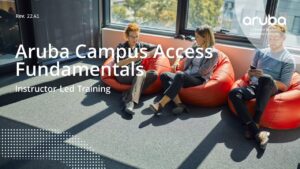

Aruba Campus Access Fundamentals Course
Aruba Campus Access Fundamentals Instructor Led Training (ILT)
Click here to register for this course
Course Overview
The Aruba Campus Access Fundamentals course teaches you the fundamental knowledge, skills, and practical experience required to configure and manage modern, open standards-based networking solutions using Aruba’s wired, wireless, security and management technologies. This course consists of approximately 60% lecture and 40% hands-on lab exercises to help you learn how to implement and validate small-to-medium enterprise network solutions. This 5-day course prepares you for the Aruba Certified Associate – Campus Access exam.
- Course ID: 0001196344
- Related Certifications: ACA – Campus Access
- Price: Contact us for Aruba partner and customer discounts.
- Duration: 5 days, Classroom – Instructor Led Training (ILT) and virtual Instructor Led Training (vILT) available
- In Preparation for Exam: HPE6-A85 – Aruba Certified Campus Access Associate Exam
- Availability: Virtual, Sydney, Melbourne, Brisbane, Canberra and Adelaide. Onsite (customer premises) available for minimum 6 people.
- Skill Level: Entry
Who is this course suited to?
The ideal candidate has 1+ years of experience with networking, vendor agnostic understanding of basic network protocols. Under the direction of a Professional or Expert, can apply the configuration and verify the status of a campus network.
It is recommended that candidates have foundational networking experience or attend Aruba’s Essentials series to glean knowledge on Aruba’s Campus Access design solution
Topics
- Networking Fundamentals
- Defines networking, LAN, WAN and their components
- Explains OSI model & encapsulation
- Discusses different types of physical media
- Compares unicast, multicast, and broadcast
- Explains TCP/IP stack
- Discusses different types of networking devices
- Switching Fundamentals
- Explains how to connect to and access a switch
- Describes initial switch setup
- Describes how to and configure VLANs, tagging, and IP addressing
- Explains how to use LLDP and ICMP for network discovery and diagnosis
- Explains how to configure link aggregation to improve performance/resiliency
- Basic IP Setup
- Discusses Inter-VLAN routing
- Explains DHCP relay
- Discusses static IP routing
- Explains how to configure single-area OSPF
- Network Redundancy
- Discusses Spanning Tree
- Explains VRRP and VSX
- VSF
- Describes VSF
- Explains how to configure VSF
- Describes Auto-VSF
- Explains VSF MAD
- Introduction to Aruba Solutions
- Discusses ESP
- Introduces Aruba switching products
- Introduces Aruba WLAN portfolio
- Introduces to Aruba Central
- Introduces to Aruba ClearPass
- Central for Device Management
- Explains how to perform device onboarding
- Describes how to create Central Groups
- Describes UI config mode
- Describes template config mode
- Describes Central licensing
- Device Profiling and AP onboarding
- Describes the use of device profiling
- Describes LLDP and MAC profiling
- Explains how to connect AP to Aruba Central
- Explains how to perform initial AP setup
- WLAN Fundamentals
- Describe the fundamentals of 802.11, RF frequencies and channels
- Explain RF Patterns and coverage including SNR
- Roaming Standards and QOS requirements
- Describe aspects of RF design
- Explains how to configure WLANs
- Implementing Secure WLANs
- Explain AAA
- Describe 802.1X authentication
- Explain how to configure secure WLANs
- Discuss roles and access rules
- Guest Access
- Describe guest access
- Explain how to setup captive portal authentication
- Describe how to configure guest WLANs
- WLAN Security
- Describe WLAN security
- Explain certificates
- Describe cloud authentication
- Monitoring and Maintenance
- Explains the use Aruba Central monitoring capabilities
- Describe how to identify LED status
- Explain how to perform firmware upgrades
- Describe how to enable SNMP on devices
- Describe AI Insights
- Describe Alerts & Reports
- Explain UXI
- Troubleshooting
- Describe how to perform password recovery and factory reset procedures
- Explain Central connectivity troubleshooting
- Describe how to enable spectrum analysis
- Explore Central Troubleshooting tools
Aruba Campus Access Fundamentals Course Objectives
After you successfully complete this course, expect to be able to:
- Explain Networking Fundamentals
- Install and configure devices running the ArubaOS-CX Network Operating System
- Describe and configure VLANs
- Explain, describe and configure Spanning Tree Protocol
- Understand when to use VRRP and how to configure it
- Explain and configure Link Aggregation
- Understand and configure IP Routing
- Understand and configure OSPFv2 – Single Area
- Describe and configure Switch Stacking using VSF
- Describe Aruba ESP platform and product portfolio
- Perform AP onboarding
- Explain how Aruba’s wireless networking solutions meet customers’ requirements
- Explain fundamental WLAN technologies, RF concepts, and 802.11 Standards
- Recognize and explain Radio Frequency Bands and channels, and the standards used to regulate them
- Describe the concept of radio frequency coverage and interference and successful implementation and diagnosis of WLAN systems
- Identify and differentiate antenna technology options to ensure optimal coverage in various deployment scenarios
- Describe RF power technology including, signal strength, how it is measured and why it is critical in designing wireless networks
- Control secure access to the WLAN using Aruba Firewall Policies and Roles
- Perform network monitoring functions and troubleshooting
